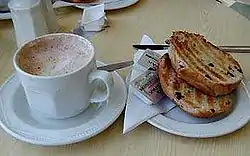Teacake
A teacake in England is generally a light yeast-based sweet bun containing dried fruit, typically served toasted and buttered.[1] In the U.S. teacakes can be cookies or small cakes. In Sweden, they are soft, round, flat wheat breads made with milk and a little sugar, and used to make buttered ham or cheese sandwiches. In India and Australia, a teacake is more like a butter cake. Tea refers to the popular beverage to which these baked goods are an accompaniment.
 A toasted English teacake (right) shown with mocha | |
| Type | Sweet roll |
|---|---|
| Main ingredients | Flour |
Regional variations
England
In most of England, a teacake is a light, sweet, yeast-based bun containing dried fruits, most usually currants, sultanas or peel. It is typically split, toasted, buttered, and served with tea. It is flat and circular, with a smooth brown upper surface and a somewhat lighter underside. Although most people refer to a teacake as a cake containing fruit, in East Lancashire, certain areas of Yorkshire and Cumbria the name currant teacake is used to distinguish fruited 'cakes' from plain bread rolls. In West Yorkshire, a large plain white or brown bread roll 9 inches or 225 mm diameter is often also called a teacake and is used to make very large sandwiches. Many cafes sell these for breakfast or midmorning snacks. In Kent, the teacake is known as a "huffkin", which is often flavoured with hops, especially at the time of harvesting hops in September. In Sussex, a luxurious version of the teacake with added aromatics such as nutmeg, cinnamon and rose water is still sometimes made and called a manchet or Lady Arundel's Manchet.
In East Lancashire, the former West Riding of Yorkshire, Cumbria and elsewhere in the North like the town of Barnsley, a teacake is a round bread roll which is cut in half to make sandwiches. They do not usually contain any sort of dried fruit. They can be made with either white, brown, wholemeal, or Granary flour (a brand of flour produced by Hovis, made by malting wheat, crushing the grains, roasting them, and then mixing them with brown flour).[2] A favourite way to eat them is to slice them into fingers, toast and then spread with butter and Bovril or Marmite.
Scotland
The Tunnock's Teacake, made in Scotland but popular throughout the UK, is a chocolate-coated marshmallow with a round biscuit base. The dome comprises Italian meringue, a whipped egg white concoction similar to marshmallow, encased in chocolate.[3]
The Tunnock's Teacake carries an important cultural significance within Scotland, including being featured at the opening ceremony of the Glasgow 2014 Commonwealth Games.
Sweden and Finland
In Sweden, the word for teacake (tekaka) refers to a sweetened wheat yeast bread. It is served warm with butter and jam. It is often served with cheese as well. In Finland there is a similar dish called teeleipä.
United States
In the Southeastern United States, a teacake is a traditional dense large cookie, made with sugar, butter, eggs, flour, milk, and flavoring.[4] They are particularly associated with the African-American community and were originally developed as an analog of the pastries served to guests by white women when entertaining.[5]
Australia/India
In Australia and India, a teacake is typically a butter cake, usually ready to serve warm from the oven in less than 30 minutes. Ingredients typically consist of flour, eggs, butter, cinnamon and sugar. It is traditionally served warm as an accompaniment to tea. Australian teacakes are sprinkled with cinnamon and fine (caster) sugar, and are usually served warm from the oven with additional butter.[6][7] Indian recipes avoid cinnamon.
Cultural references
Teacake features as a passing subject of discussion in The Importance of Being Earnest by Oscar Wilde.
"Tea Cake" is the name of one of the characters in the Zora Neale Hurston novel Their Eyes Were Watching God.
See also
- Chocolate teacakes, a kind of chocolate-coated marshmallow treat
- Coffee cake, a class of cakes that are served with coffee
- Funing big cake
- List of sweet breads
- Madeleine (cake), a type of individual French cake, shell shaped
- Russian tea cake, also called Mexican wedding cookies, a kind of cookie that originated in Russia
- Tea (meal)
- Tea culture
- Tea loaf
References
- Concise Oxford English Dictionary, Eleventh Edition (revised) 2006
- "Granary®". Rank Hovis. Retrieved 12 June 2012.
- Robert Lea (14 April 2010). "The Willy Wonka of Tannochside: Tunnock's MD, Boyd Tunnock". The Times. Archived from the original on 24 April 2011. Retrieved 24 April 2011.
- The Georgia Cook Book, Georgia Home Economics Association. Atlanta, 1980.
- Karen Grigsby Bates (2016-06-19). "Food To Celebrate Freedom: Tea Cakes For Juneteenth!". Retrieved 2016-06-20.
- "Cinnamon tea cake". Taste.com.au. 1 January 2010. Retrieved 4 May 2020.
- "Cinnamon teacake". Player.fm. Retrieved 4 May 2020.
